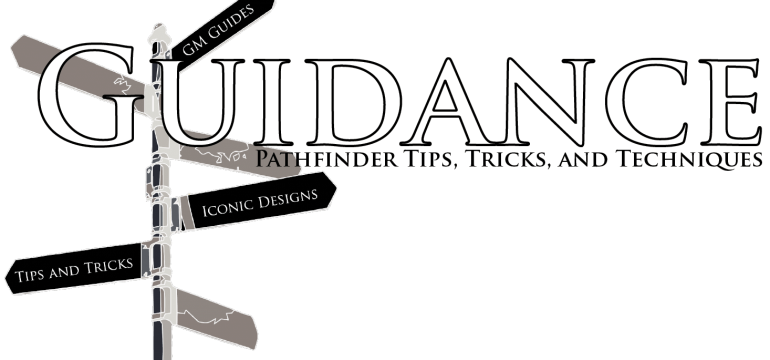Hey everyone, welcome to Guidance! I’m Alexander Augunas, the Everyman Gamer, and today I’m back for another installment of designer water cooler. So, how often does this happen to you? You’re the GM of a game, and prior to play one of your players decides on a character concept that ends up being less then desirable. This can happen for a multitude of reasons. Sometimes your player picks a bunch of neat options that ultimately don’t fit well together. Other times they might pick an option that looks cool on paper, but ultimately the option isn’t that great. What do you, the GM, do?
If it’s the first option, a simple hand-wave and a retrain are easy enough as long as the problem is identified soon enough and the player doesn’t completely change into an all-new character. Pathfinder and Starfinder even have rules for this (though admittedly Starfinder is WAY harsher about retraining then Pathfinder is). But what if its the second option? What if the player loves the flavor, but the option itself under performs? Well, sometimes the best answer might be to design some rule that the player can take that’ll “fix the issue,” so to speak. How do you do that? I’m glad you asked! This week I’m going to be going over a real-world example for how I design things to fill a niche. Let’s get started.
Step 1: Identify the Problem
So in our Dead Suns game, we have a player who’s been REALLY unhappy with her solarion build as of late. She plays a weapon solarion in Starfinder Society, so she thought she’d try an armored solarion in the playtest. A big problem that we’re running into, however, is that her solarion armor does NOT live up to expectations. It doesn’t provide her with much benefit when she’s not directly in combat, and even when she’s engaged enemy attack rolls are still often high enough that they seem to hit her frequently. She’s clearly frustrated with her character choice, so I figured I would see what I could do to help! In this case, our problem is clearly that the player is not satisfied with the solarion armor ability. On a deeper level, the armor doesn’t seem to substantially improve her combat functionality or survivability compared to other characters—in this case, the most direct comparison would likely be my soldier, Shoku.
But before we can truly say that the problem is identified, we need to do some number crunching. After all, it’s hard to get conclusive evidence that a solution is needed without data. Without further adieu, here’s my spreadsheet information on the topic. Please note that I am a fallible human being, and there’s always an off-chance that I typed in an armor’s value incorrectly. Turns out it is crazy difficult to input every light and heavy armor in the Core Rulebook into a spreadsheet, and that mistakes happen. Go figure. If you see a mistake, note it in the comments and I’ll do what I can to fix it. Thank you.
Okay! Let’s start by explaining my methodology with the data. This spreadsheet consists of two pages. Page 1 lists every Armor of both the Heavy and Light variety in the game. Yellow highlights are the best Light Armor bonuses for their item level, while Orange highlights are the best Heavy Armor bonuses. Here’s some notes:
Page 1: Armor Comparisons
- I prioritized KAC over EAC. That’s why I listed KAC first instead of EAC. Sadly, I had to pick one to prioritize (just like players do) and that’s what I picked. When possible, I picked the armor with the best KAC and EAC overall. This happened surprisingly frequently.
- If there were multiple armors that were tied for the highest bonus, I picked the armor that had the lower Maximum Dexterity. Lower Max Dex means its more likely that a PC can get the most out of that kind of armor.
Page 2: Class Comparisons
- I copied Page 1 and removed all armors that weren’t best for their item level.
- For the Solarion column, I assumed the Solarion had the Solarion Armor class feature, which gives a +1 enhancement bonus at 1st level, increasing to +2 at 10th-level.
- For the Soldier column, I assumed the Soldier had the Guard fighting style, which raises the Soldier’s maximum Dexterity bonus by 1, as well as Armored Advantage, which gives a +1 insight bonus to AC at 3rd level. It’s worth noting that because of this, it’s unlikely that a lightly armored soldier is going to have the full Dexterity bonus indicated by the column because its unlikely that they’ll have a Dexterity modifier capable of equally or exceeding their armor’s Max Dex +1. However, it is still a valid bonus for the soldier (though it’s very likely that the soldier will need to invest in personal upgrades to raise their Dexterity modifier or invest at least a 14 into Dexterity to make it worthwhile.
Findings
- A soldier in light armor stays roughly 1 AC ahead of their armored solarion counterparts at nearly every level.
- A soldier in heavy armor stays roughly 2 AC ahead of their armored solarion counterparts at nearly every level.
- Solarions can take gravity shield at 14th-level, which gives them a +1 circumstance bonus to AC for 1 round as a move action. Since this is a huge action economy tax that the soldier doesn’t incur to use their class features, I discounted this revelation.
- It’s worth noting that Armored Advantage is the only ability currently in Starfinder that adds an insight bonus to AC, meaning that it’ll stack with basically everything currently out. In contrast, mechanics have a class feature that adds a +1 enhancement bonus to an ally’s AC, so a mechanic wouldn’t be able to use this ability on an armored solarion.
Verdict
When you compare the armored solarion, a class option that requires a major character building decision that you can’t change, to a soldier with the guard fighting style and Armored Advantage gear boost, the solarion comes out 2 KAC behind (and 1 EAC on average). This seems like a pretty solid mathematical justification for designing something that helps armored solarions “bridge the gap” between themselves and soldiers.
Step 2: Brainstorm Solutions to the Problem
The next step in the process of designing to fill a niche is to brainstorm several solutions to fix the problem that we’ve identified. This mostly relies on a combination of your knowledge of the rules and your creativity. After each solution, you should try to come up with 1 Pro and 1 Con for it. With a bit of brainstorming, this is what I came up with:
- Feat to Boost Solarion Armor.
- Pro: Quick. Few feats in SF. Power level of a feat varies, and presence of prerequisites means that they’re easier to gate.
- Con: Solarions don’t get many, and this could be feat-tax territory. (A feat tax is a feat that your character HAS to take to do the cool thing they want to do.)
- Solarion Revelation to Boost Solarion Armor.
- Pro: Part of the core class design.
- Con: Might be too strong compared to existing revelations. Doesn’t sync up with the soldier’s gear boost (3rd level). Becomes a required choice. Risks throwing the solarion out of “balance” between proton and graviton.
- Armor Upgrades to Boost Solarion Armor.
- Pro: Part of armor design.
- Con: Might not make sense. Who built a little machine to boost an unknown spiritual force. Doesn’t “feel” very solarion.
- Solarion Armor Crystals to Boost Solarion Armor
- Pro: Unique. Could be a neat counterpart to a type of gear that weapon solarions get that armor solarions don’t. Potential for a lot of customization / story elements.
- Con: “Credit Tax:” if too expensive, they could be a fine that armored solarions feel they need to pay to be competent. Risk feeling like “reflavored armor upgrades” if not handled well.
Choosing a Solution
One of the important things to remember about choosing a solution is that it isn’t need to be set in stone; if you start working with a solution and it doesn’t work, scrap it and try a different one! With this in mind, I think I’m going to take the risky route and try to design solarion armor crystals for my friend. The “cool armor-solarion-only” aspect is something that I think I can work with, and if I’m careful I can try to design them so they aren’t too expensive. In the long run, I think a credit tax that establishes a new item type for players to use to customize their characters is less prohibitive then a feat tax or a class feature tax, and I can make sure my design doesn’t accidentally boost soldiers by making it not an armor upgrade.
That’s all for this week’s installment of Guidance! Next week we’re going to tackle the solarion armor crystal design head-on, establish some goals for the mechanic and figure out how we want it to work. With luck, we might even have a sample solarion armor crystal put together for our enjoyment! Until next time, I’m Alexander Augunas, the Everyman Gamer, and I’m always here to offer you a little bit of Guidance!
Alexander “Alex” Augunas has been playing roleplaying games since 2007, which isn’t nearly as long as 90% of his colleagues. Alexander is an active freelancer for the Pathfinder Roleplaying Game and is best known as the author of the Pact Magic Unbound series by Radiance House. Alex is the owner of Everyman Gaming, LLC and is often stylized as the Everyman Gamer in honor of Guidance’s original home. Alex also cohosts the Private Sanctuary Podcast, along with fellow blogger Anthony Li, and you can follow their exploits on Facebook in the 3.5 Private Sanctuary Group, or on Alex’s Twitter, @AlJAug.






